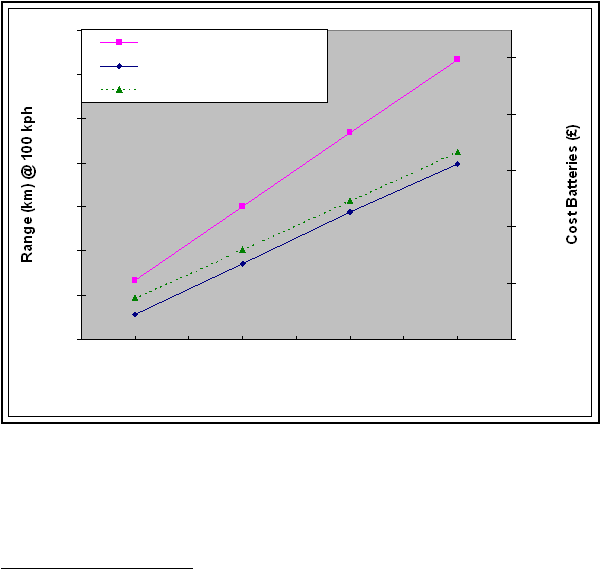
Advanced battery technologies such as Nickel-metal hydride and Lithium Ion have the potential to increase the
performance and range of BEVs, but these are presently only suitable for high value niche cars, or hybrid
vehicles that use small batteries. As with fuel cells, these high performance batteries are unlikely to have any
direct significant impact on the mass car market in the near future due to their high cost.
Despite their weight, lead acid based batteries with useful power density; affordability and durability are being
overlooked. To illustrate their viability, the vehicle range and cost of batteries are calculated for two small
aerodynamic car bodies using a commercially available, high energy density, lead acid technology.
38
The running cost comparison of a BEV using these batteries with two gasoline ICE cars for various annual
distances travelled is shown in figure 12 and the overall saving in the running costs by using battery propulsion
instead of an ICE in a small and average car in figure 13. These calculations assume that the replacement cost
of the batteries as well as the cost of the electricity to charge the batteries is included as a running cost. These
calculations exclude any costs due to the additional servicing and repair and the environmental costs of using an
IC engine.
This analysis suggests that approximately 300kg of these lead acid batteries would provide approximately 85-
125km of range whilst travelling at a constant speed of 100 kph and the cost of batteries would be around
£1300. Since the batteries used for this calculation are guaranteed for 5yrs, it is assumed that their cost would
be a maximum of £260/year. An average car travelling 10000 km/year, using batteries would amount to saving
of typically £400/yr over an ICE equivalent vehicle, although the saving for a smaller more aerodynamic car
with the ranges illustrated in figure 12 would be typically only £200/yr. Whilst operating under urban
conditions, the BEV would exhibit greater savings in cost, energy and carbon due to the much higher efficiency
of an electric than an IC engined car for this type of operation, however in this case a BEV is unlikely to
accumulate a large annual mileage.
50
75
100
125
150
175
200
225
200
300
400
500
Weight Batteries (kg)
500
1000
1500
2000
2500
3000
Honda Insight Range (km)
Audi A2 Range (km)
Cost Batteries (£)
Figure 12 Range and cost of using commercially available lead-acid battery
technologies for powering two cars
39
38 commercial battery &
39 See ‘spreadsheet 2’ “CO2 and fuel for various vehicle configurations’ sheet ‘range vs weight electric cars”

